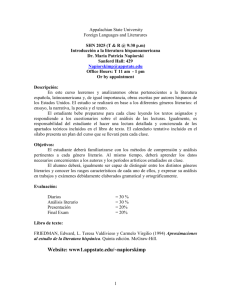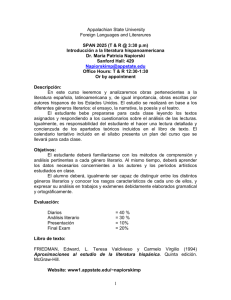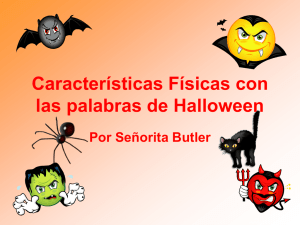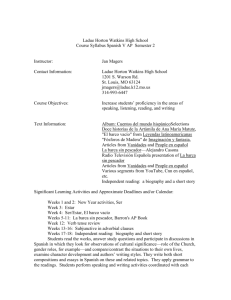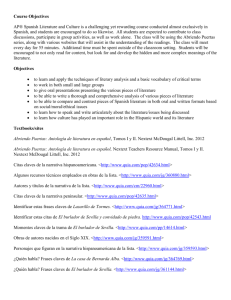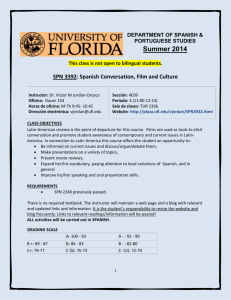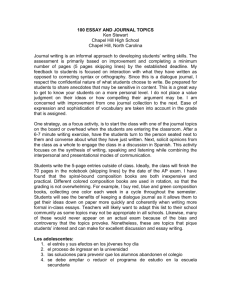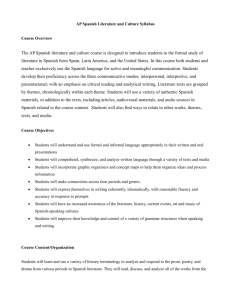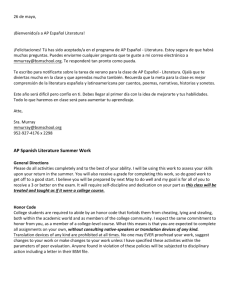Mr. Pérez-Llorente syllabus. Heritage Spanish 3
advertisement
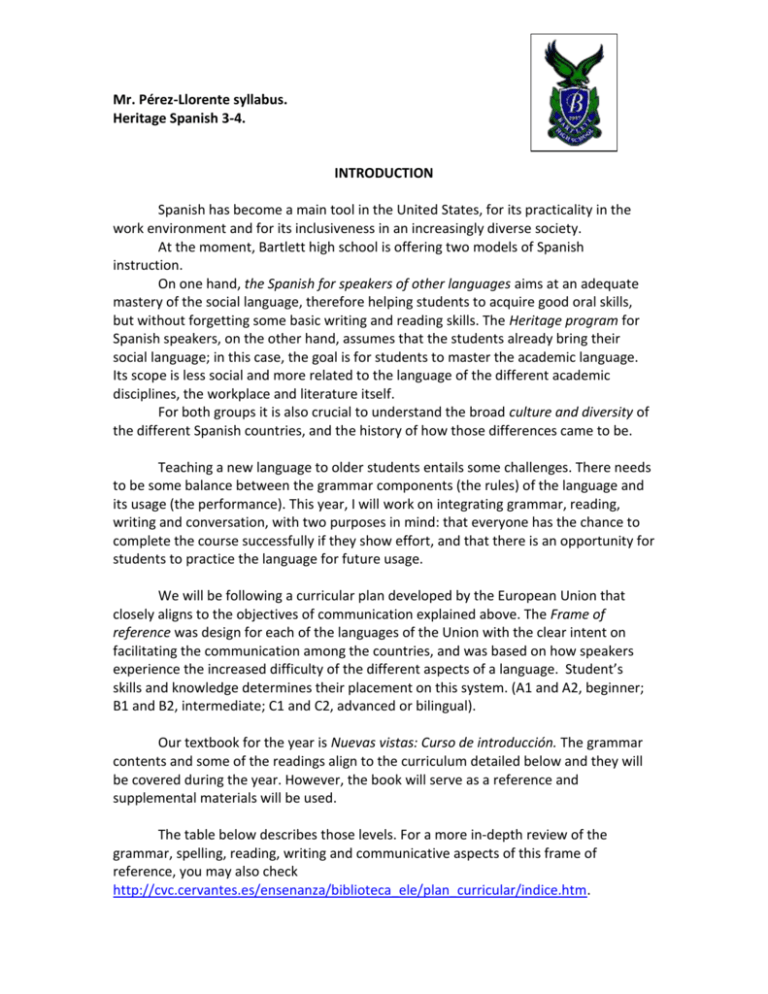
Mr. Pérez-Llorente syllabus. Heritage Spanish 3-4. INTRODUCTION Spanish has become a main tool in the United States, for its practicality in the work environment and for its inclusiveness in an increasingly diverse society. At the moment, Bartlett high school is offering two models of Spanish instruction. On one hand, the Spanish for speakers of other languages aims at an adequate mastery of the social language, therefore helping students to acquire good oral skills, but without forgetting some basic writing and reading skills. The Heritage program for Spanish speakers, on the other hand, assumes that the students already bring their social language; in this case, the goal is for students to master the academic language. Its scope is less social and more related to the language of the different academic disciplines, the workplace and literature itself. For both groups it is also crucial to understand the broad culture and diversity of the different Spanish countries, and the history of how those differences came to be. Teaching a new language to older students entails some challenges. There needs to be some balance between the grammar components (the rules) of the language and its usage (the performance). This year, I will work on integrating grammar, reading, writing and conversation, with two purposes in mind: that everyone has the chance to complete the course successfully if they show effort, and that there is an opportunity for students to practice the language for future usage. We will be following a curricular plan developed by the European Union that closely aligns to the objectives of communication explained above. The Frame of reference was design for each of the languages of the Union with the clear intent on facilitating the communication among the countries, and was based on how speakers experience the increased difficulty of the different aspects of a language. Student’s skills and knowledge determines their placement on this system. (A1 and A2, beginner; B1 and B2, intermediate; C1 and C2, advanced or bilingual). Our textbook for the year is Nuevas vistas: Curso de introducción. The grammar contents and some of the readings align to the curriculum detailed below and they will be covered during the year. However, the book will serve as a reference and supplemental materials will be used. The table below describes those levels. For a more in-depth review of the grammar, spelling, reading, writing and communicative aspects of this frame of reference, you may also check http://cvc.cervantes.es/ensenanza/biblioteca_ele/plan_curricular/indice.htm. NIVEL SUBNIVEL A = Usuario Básico A1 (Plataforma) A2 (Acceso) B = Usuario Independiente. B1 (Umbral) C = Usuario Competente DESCRIPCION El usuario básico: A1 y A2. La persona capaz de comunicarse, en situaciones muy cotidianas, con expresiones de uso muy frecuente y utilizando vocabulario y gramática básica. El usuario independiente: B1. Es capaz de desenvolverse en la mayor parte de las situaciones que pueden surgir durante un viaje por zonas donde se utiliza la lengua objeto de estudio. B2 (Avanzado) El usuario independiente: B2. Puede relacionarse con hablantes nativos con un grado suficiente de fluidez y naturalidad, de modo que la comunicación se realice sin esfuerzo por parte de los interlocutores. C1 (Dominio Operativo Eficaz) El usuario competente: C1. "Dominio operativo adecuado". Representa un nivel avanzado de competencia apropiado para tareas más complejas de trabajo y estudio. (Generalmente este nivel lo alcanzan personas con estudios académicos medios o superiores en su lengua materna) C2 (Maestría) El usuario competente: C2. Aunque el nivel C2 se ha denominado «Maestría», no implica una competencia de hablante nativo o próxima a la de un nativo. Lo que pretende es caracterizar el grado de precisión, propiedad y facilidad en el uso de la lengua que tipifica el habla de los alumnos brillantes. GRADING SYSTEM The grading system will be different than in previous years. Formative assessment Like in previous years, students will work on passages, videos, projects, prompts, grammar exercises and other activities. a) La hoja de ruta will be a document containing all grammar contents that need to be mastered, a brief review of the lectures presented in the classroom, and leveled activities for that content. Students will be able to self-assess how well they know the grammar before the exam by checking the mistakes in one of the sections and reviewing before moving to the next section. Students able to complete la hoja de ruta without problems or external help will have no issues with the grammar exam. b) Students will be reading fiction and non-fiction passages and will be working on different objectives on them. They will be able to check if they can reach those objectives and will be tested on them but not graded. c) Students will be writing fiction and non-fiction pieces covering different objectives. They will be able to check if they can reach those objectives. They will have feedback on how to improve their writing from other students and the teachers. d) Students will also complete Exit slips, quizzes, and projects. Please be aware that all the items above will be formative assessment but will not be graded. It is expected that the students will work on them to be prepared for the summative assessments. It is likely that students failing to turn in or to accurately complete these assessments will fail the summative assessments. On the other hand, any student struggling with the assignments will be offered extra help in the classroom or outside the classroom (provided they showed effort prior). Summative assessment. The students will be tested at the end of each quarter, lesson or unit of study. The grammar, reading and speaking test are cumulative, that is, the information tested on one exam will be also tested in the following one. For the semester grade, the students will be able to choose between an average of the final grades for the two quarters, or the second quarter grade (or the average between third and fourth, or the fourth quarter grade). The grade will be calculated as follows: a) Reading and vocabulary (20%). Multiple choice questions. We will cover it Mondays. b) Writing (20%). Fiction or non-fiction piece. Based on a rubric. Tuesdays. c) Grammar component (20%). Multiple choice questions. Wednesdays. d) Speaking (20%). Oral presentation of three to five minutes. Based on a rubric. Thursdays. It will also include debates. e) Project (10%). f) Binder (10%). g) Fridays will be open to review/complete contents from other days, for testing, and for culture. A) Grammar component. Students will know in advance what grammar objectives will be included in the test. These will be taught in the class, and summarize in the package hoja de ruta. This package will have activities (from easiest to hardest), intermediate milestones (for students to check their progress), and a final exit form to check completion. B) Debate/ reading and vocabulary. Students will memorize vocabulary words, use them in context, and learn reading strategies. The reading/vocabulary exam will contain one or more of the passages in the classroom with different questions. C) Writing. Students will write fiction or non-fiction passages. Several drafts will be checked to improve the writing before the writing exam. D) Speaking. Students will have to verbally present one topic during three to five minutes. Notes cannot be used during the oral presentation. E) *Check section for projects. F) Binders. A 10% of the final score will be awarded to students keeping a complete and organized binder. This need to include the day, the notes for the day, need to be exclusive for Spanish and follow an order. Students will WRITE THEIR NAMES AND PERIOD ON THE SPINE OF THE BINDER and leave it in the classroom. Each period will have its own bin. Other papers (hoja de ruta, rubrics…) will be hole punched. Students that would rather bring their binders home may do so after asking for approval. CURRICULUM The curriculum for Heritage Spanish 1-2 and for Spanish 7-8 will be based on the European Reference Frame. Following are the concepts covered and the quarters when they will be presented: SPEAKING. It will also include the grammar components for the same period. Heritage Spanish 3-4 First semester Identificar utilizando oraciones de relativo (1) El + (sustantivo-adjetivo) + oración de relativo + sintagma verbal. El estudiante que cumpla con sus tareas aprobará la asignatura. Identificar utilizando oraciones de relativo (2) El/este + (sustantivo) + de + oración simple. El del carro deportivo va demasiado rápido. Identificar utilizando oraciones de relativo (3) Verbo + un + oración de relativo en indicativo. Busco una cartera de cuero que tiene remaches rojos. Dónde/de dónde. Adónde/a donde. Inmediatez. Tan pronto como, inmediatamente antes/después, en cuanto. Explicar la finalidad con a qué, para qué/ a que, para que. Explicar la causa con debido a que, ya que, puesto que, por si. Corregir información previa con no solo…, sino que… No estoy del todo de acuerdo. Yo comparto tu opinión, punto de vista (pero)… Pienso justo lo contrario… A mí (no) me lo parece… No estoy (en absoluto) de acuerdo con…Tienes razón, pero… De acuerdo, pero… Puede que sí/no, pero… Estoy (totalmente/completamente) seguro de que… No estoy muy seguro de que + presente subjuntivo. No está claro/ no es evidente + presente subjuntivo. Second semester Yo diría que… Imagino que… Es dudoso que… Futuro imperfecto de indicativo como duda. Serán la cinco. (No) me suena + sintagma nominal/ + infinitivo compuesto/ + que… Me suena este lugar. Me suena haber estado aquí. Me suena que estuvimos en este lugar. Me encanta/entusiasma/fascina que + subjuntivo. Me fascina que me regales flores. De niño, me encantaba que me regalaran dulces. Preferiría que + subjuntivo (pero)… Estar indignado con… Me pone de mal humor/enfada/da rabia/histérico/nervioso/ desespera ¿Me echas una mano (con…)? Te he dicho (mil veces) que + presente de subjuntivo. Me desilusiona/decepciona + subjuntivo. Lamentar que + subjuntivo. Es una pena/ lástima que + subjuntivo. ¡Qué pena/ lástima que + subjuntivo. Lamento que no hayas conseguido el trabajo. Es una pena que no sigan juntos. ¡Qué pena que no tengamos el número ganador! Detesto/Odio/No soporto/Me molesta/Me disgusta/Me da asco que + subjuntivo Está prohibido/ No está permitido que… Si yo fuera tú,… Lo mejor sería que… Te aviso/recuerdo/advierto que… GRAMMAR Heritage Spanish 3-4 First quarter Género y número de los sustantivos (avanzado) Prefijos y sufijos en adjetivos. Cambio de significado de los adjetivos dependiendo de la posición. Sustantivación mediante el artículo y el neutro lo. Comparativos latinos cultos y con prefijos super-, extra-, re-, archi- y ultra-. Los nombre escuetos: ausencia de determinación. Pronombres personales tónicos después de preposición. Excepciones con entre, hasta, según. El pretérito pluscuamperfecto. Repaso de todos los pasados. Second quarter Dativo posesivo. Posesivo por pronombre. Te hago la cama. Numerales. Ordinales, universales y no universales (cada, algo, alguien, alguno, nada, nadie, ninguno, poco), partitivos. Contraste un/algún, cualquier/cualquiera, solo/incluso. Partitivos (mayoría, grupo, montón…) y concordancia. Posición, presencia y ausencia de lo. Pronombres relativos en oraciones subordinadas (que, el que, quien…). Contraste que/quien. Oraciones de relativo explicativas o restrictivas. Antecedentes de indicativo. Los interrogativos y exclamativos con y sin preposición. Posición y uso. Repaso del resto de los tiempos del indicativo. Futuro y condicional. Third quarter Valores habituales y valores trasladados del presente, el pretérito imperfecto y el indefinido. Valores habituales y valores trasladados del condicional y el pluscuamperfecto. El presente de subjuntivo en oraciones independientes; de desconocimiento; subordinadas adjetivas, adverbiales de lugar y de modo; temporales introducidas por una vez que, mientras, hasta que, en cuanto, tan pronto como con matiz de posterioridad; concesivas de indiferencia con aunque, a pesar de; adverbiales introducidas por a que. El imperfecto de subjuntivo en oraciones independientes; con adverbios de duda quizá, tal vez; imperfecto de cortesía. El pretérito perfecto de subjuntivo. El pluscuamperfecto de subjuntivo. Fourth quarter Perífrasis verbales. Verbos con preposición. Oraciones subordinadas sustantivas de infinitivo con función de sujeto, OD. Oraciones subordinadas sustantivas con que con función de sujeto, OD. Oraciones subordinadas sustantivas con ser, estar y parecer. Oraciones subordinadas adverbiales (intermedio). Oraciones de anterioridad, posterioridad, simultaneidad, delimitación, destino, modo, causa, final, condicional y consecutivas. WRITING Heritage Spanish 3-4 First quarter Los adverbios terminados en –mente. Uso, ejemplos y colocación. De lugar, tiempo, modo, frecuencia… Escribir oraciones simples utilizando ser, estar y haber. Oraciones impersonales con el verbo haber. Escribir oraciones simples con verbos transitivos y dos objetos. Escribir oraciones simples con los verbos gustar, encantar, doler y similares. Finalmente… En conclusión… En resumen… Para terminar… Al final… Presente, presente irregular y pretérito perfecto en narración. Géneros: carteleras, ofertas de trabajo, cuentos, resúmenes, descripciones y cartas no formales. Second quarter Dativo posesivo. Oraciones compuestas con y, ni. Oraciones compuestas con o, pero, uno…otro… Oraciones compuestas con infinitivo con verbos como gustar. Le encanta ir al cine. Hasta la próxima. A ver si nos vemos/ nos volvemos a ver pronto. A la espera de sus noticias, le(s) saluda atentamente. Saludos cordiales. Cordialmente. Sin otro particular, se despide. Atentamente. (Reciba) un cordial/atento saludo. Y de repente, y de pronto…. Introducción a las oraciones causales, finales, temporales, condicionales, comparativas y de modo. Géneros: anuncios publicitarios y recetas (con imperativo), textos narrativos y cartas formales (pedido, confirmación, reclamación y solicitud de trabajo). Third quarter Oraciones simples dubitativas con indicativo. Oraciones simples recíprocas, impersonales y pasivas reflejas. Oraciones compuestas con ni… ni… Oraciones de relativo especificativas o restrictivas, con indicativo y subjuntivo. Oraciones de relativo explicativas. Explicar la finalidad con a qué, para qué/ a que, para que. Explicar la causa con debido a que, ya que, puesto que, por si. Corregir información previa con no solo…, sino que… Géneros: anuncios publicitarios, artículos de opinión, biografías, obras de teatro, cómics. Fourth quarter Oraciones subordinadas sustantivas de infinitivo con función de sujeto, OD. Oraciones subordinadas sustantivas con que con función de sujeto, OD. Oraciones subordinadas sustantivas con ser, estar y parecer. Oraciones subordinadas adverbiales (intermedio). Oraciones de anterioridad, posterioridad, simultaneidad, delimitación, destino, modo, causa, final, condicional, concesivas, comparativas y consecutivas. Géneros: poemas, canciones, y chistes SPELLING Heritage Spanish 3-4 First semester Uso de las letras c, k, q, z y ch. B en imperfecto de indicativo con primera conjugación y con ir. V en indefinido de andar, estar, tener y compuestos de estos verbos. Llanas que terminan con –ava, -avo, -eva-, -eve, -evo, -iva, -ivo. C en plurales con singular en –z. J en palabras que terminan con –aje. H en ahora. Homófonos frecuentes hecho/echo, ha/a/ah, hola/ola Y en leyendo, oyendo, yendo. Y en verbos terminados en eer, oir, uir. (leyeron, oye, huyeron). LL en palabras que terminan en –illa, -illo. Las palabras según su acento. Colocación de la tilde en agudas, graves, esdrújulas, diptongos, hiatos, adverbios en mente e imperativos. Contraste entre interrogativos, exclamativos, relativos y nexos subordinantes a la hora de escribir la tilde. Second semester B en verbos con –bir, palabras compuestas con bien-, palabras que empiezan con bio-, biblio-. B en palabras que terminan en –bilidad. V en pretérito imperfecto de subjuntivo de andar, estar, tener. (Estuviera) V con imperativo y presente de subjuntivo de ir. V en verbos que terminan en –olver. C en palabras con sonido final /k/. Coñac. Parónimos c/s y z/s. Cocer/coser. Caza/casa. Sustitución de c por qu en indefinido y presente de subjuntivo de verbos terminados en –car. ZC en primera persona de presente de verbos que terminan con – acer, -ecer, -ocer, -ucir. Mayúsculas y minúsculas en fechas, idiomas y títulos de obras. Grupos güe y güi. MATERIALS 1) Bring pen or pencils every day, and a binder. Binders can be storage in the classroom if the student wishes to do so. 2) Though they are dictionaries in the class, students should also their own bilingual dictionary. Larousse, Merrian- Webster's, Vox... are good choices. 3) There are some leveled books in the classroom for the project, but not enough for every student. Students should buy their own. *Check the project section. PROJECTS Projects are per semester. Two projects are needed. There are two kinds of projects to complete: 1) Read a book. a. You can read a leveled book. Google leer en español Santillana nivel 3 to 4 in Amazon for a selection. These books come with a CD, a glossary, and questions and activities at the end. Write a summary of the book and answer/complete all the activities. Pick a level based on how comfortable you feel reading in Spanish. b. You can also Google Lecturas graduadas intermedio/avanzado or lecturas graduadas nivel 2 for more variety. Most of these books do not have a CD nor activities at the end. You will have to summarize every chapter of the book in between 100 to 200 words per chapter. Each publisher follows its own leveling system. When in doubt, please consult with me c. You can read Papel mojado by Juan José Millás, La aventura de Said, by Josep Lorman, La casa de Bernarda Alba by Federico García Lorca, or Ética para Amador by Fernando Savater (non-fiction book) . If you choose to read any of these books, you will have a multiple choice test with at the closing of the semester with a pass-fail grade. 2) Do some volunteer work. a. You can participate in some place where volunteer work in SpanishEnglish is required. A rubric will state the number of minimum hours, objectives… You will have to present a project-artifact to the class orally, in Spanish, to pass this section. HOMEWORK This year homework will be a revision of the contents learned in the classroom. It will not be graded. Students should focus on completing their projects and reading in the house as well. WEBSITE Please check http://perezllorente.wikispaces.com/ for electronic copies of the syllabus and of other documents. LATE WORK You can turn late work any time for review or advice. Please allow sufficient time so I can make comments. Notebooks will be turned in at least a week before the closing of the period. Projects need to be completed two weeks before that date. If you chose to volunteer, you will turn in your project following that deadline but may present later on. LANGUAGE USAGE Unless there is a need to do so, only Spanish will be used in the class. DELE (Diploma de Español como Lengua ExtranjeraDiplomas of Spanish as a Foreign Language). Tentatively, I will offer a group for the preparation of DELE if enough students sign for it. It would be an after school club. What is DELE? DELE is the only recognized accreditation for Spanish. It is issued by the Ministry of Education of Spain. Tests are offered twice a year through the Instituto Cervantes in Chicago. It has different levels ranging from intermediate to fully bilingual. To pass, students need to demonstrate mastery of all skills: grammar, reading, writing, listening and conversation. Though mostly unknown in the Americas, it is nonetheless a formal and official way to prove the mastery of the language when searching for a job. If a group of interested students is created, we will be working on all the skills of the test. The students that choose to participate in this group will not have to complete any semester projects as long as they sign up for the test.
